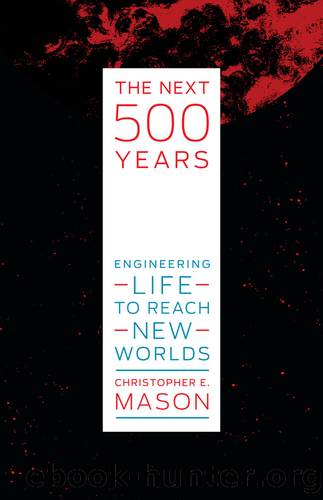The Next 500 Years: Engineering Life to Reach New Worlds by Christopher E. Mason

Author:Christopher E. Mason [Mason, Christopher E.]
Language: eng
Format: epub
Tags: Medical, Internal Medicine, science, Life Sciences, Genetics & Genomics, Space Science, General, Technology & Engineering, Biomedical
ISBN: 9780262044400
Google: 7kslEAAAQBAJ
Publisher: MIT Press
Published: 2021-07-15T00:34:45.790013+00:00
The Half Unknown
Dr. Venkateswaranâs analysis of organisms on the ISS showed a large span of variations ranging from what looked like an entirely new species of an existing genus to fragments of DNA that did not align to any known genome at all. However, this is not unusual by itself. When the shotgun-sequencing data from the NYC subway was analyzed by our group in 2015, and again globally in 2021, we showed ~50 percent of the sequenced DNA was completely novel and had never been seen before. Similar numbers were observed when the geneticist Craig Venter used shotgun sequencing in the Sargasso Sea. Thus, the biggest factor driving the mystery DNA found on the ISS is likely not aliens or anything otherworldly at all, but instead limitations to our current reference databases. Given an estimated trillion species on Earth in 2020, with only about 100,000 having reference genomes to which we can compare, it is a small miracle that we can routinely identify anything we capture at all.
As we sequence more and more diverse locations around the world, the number of âunknownâ fragments of DNA will decrease. A new species from the ISS was even named after Kate Rubins (Kineococcus rubinsiae) in 2020. However, the unknown fraction can never reach zero; there will always be a sequence that we have never seen before. This is because life is always evolving, especially within some bacteria and viruses that replicate in a matter of minutes. Thus, even if one had a complete and total genetic catalog of all life living anywhere on Earth, it would be incomplete only a few minutes later.
However, this does not mean we should stop searching for new unknowns. To even attempt our planetary-protection initiative, we need to analyze all fragments of DNA we can find in any and all spacecrafts (which, it just so happens, is exactly what we do). With the work by Drs. Venkateswaran, Smith, and others at JPL, shotgun sequencing and surveillance of the spacecraft is now a standard metric for the estimates of forward contamination. These data are then compared to the total index of all sequenced DNA that has ever been seen on Earth to identify what is present, and what might be accidentally propelled into space on the next mission.
So far, the results are very clear. We have unquestionably contaminated Mars, and possibly other planets as well. While the âbioburdenâ of these missions has been consistently low, it has never been zero, not even the Viking landers of the 1970s. For Mars, this is particularly problematic, due to the planetary dust storms capable of picking up and spreading the contamination across its surface. As such, chances are low that we will be able to maintain contamination-free areas of Mars above ground. This means that if any life is found on Mars, it would need to be dramatically different from anything seen on Earth for us to be confident that it is Martian in origin.
In other instances, planetary-protection measures have been far more rigorous.
Download
This site does not store any files on its server. We only index and link to content provided by other sites. Please contact the content providers to delete copyright contents if any and email us, we'll remove relevant links or contents immediately.
Whiskies Galore by Ian Buxton(40332)
Introduction to Aircraft Design (Cambridge Aerospace Series) by John P. Fielding(32338)
Small Unmanned Fixed-wing Aircraft Design by Andrew J. Keane Andras Sobester James P. Scanlan & András Sóbester & James P. Scanlan(32141)
Aircraft Design of WWII: A Sketchbook by Lockheed Aircraft Corporation(31773)
Craft Beer for the Homebrewer by Michael Agnew(17447)
Turbulence by E. J. Noyes(7039)
The Complete Stick Figure Physics Tutorials by Allen Sarah(6638)
The Institute by Stephen King(6262)
Kaplan MCAT General Chemistry Review by Kaplan(6054)
The Thirst by Nesbo Jo(5786)
Bad Blood by John Carreyrou(5769)
Learning SQL by Alan Beaulieu(5412)
Weapons of Math Destruction by Cathy O'Neil(5037)
Permanent Record by Edward Snowden(4999)
Man-made Catastrophes and Risk Information Concealment by Dmitry Chernov & Didier Sornette(4737)
iGen by Jean M. Twenge(4702)
Navigation and Map Reading by K Andrew(4554)
Digital Minimalism by Cal Newport;(4544)
Life 3.0: Being Human in the Age of Artificial Intelligence by Tegmark Max(4508)
